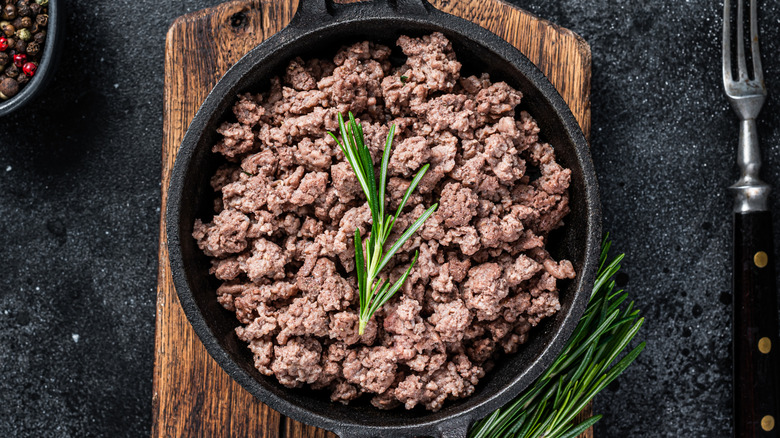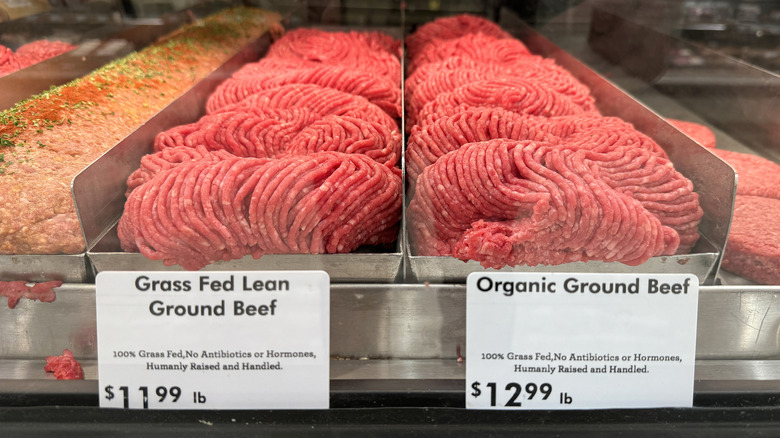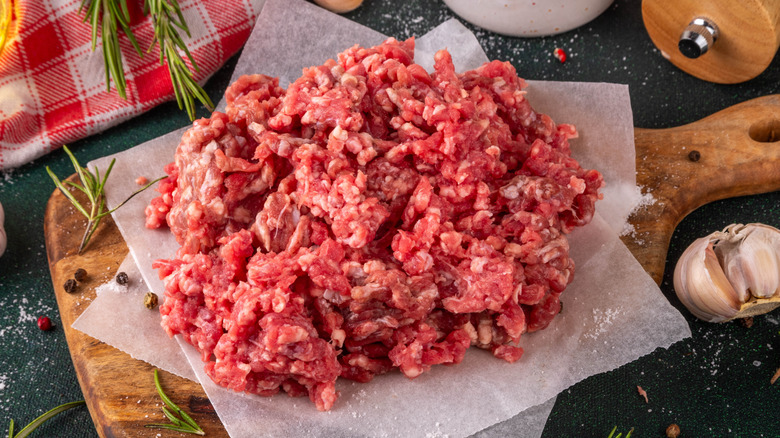Ground Beef Vs Beef Mince: When To Use One Or The Other
It's amazing to me that you can go through life believing something and then come across a little tidbit of information that kind of blows your mind because you've never thought about it too deeply. For me, that nugget of information was that ground beef and beef mince are not the same food item. Those words might seem interchangeable, and that's because most people treat them like synonyms.
There's not an ocean of differences between the two, but they do diverge in ways that could affect what you're cooking. Ground beef and minced meat probably look the same if you're not really paying attention, though they vary in appearance to some degree. Mainly, though, ground beef has additional fat added to it and has a fine grind, whereas minced beef is just pure, 100% meat with no additives and a slightly coarser texture.
In most grocery stores in the United States, you'll primarily see "ground beef," while "beef mince" is more common in the United Kingdom and other parts of the world — so these differences can vary from place to place. But beyond just the names, the two products tend to behave differently in recipes – and knowing how to use each one can make a difference in the final dish.
Ground beef brings fat and flavor to the table
Ground beef is what most American recipes call for, and it comes in a variety of fat percentages. From the leaner 90/10 to the juicier 80/20 blends, the ratio of fat in ground beef can affect both the texture and taste of what you're making. Because of that fat, ground beef is especially great for dishes that benefit from a little extra richness, like burgers, meatloaf, or tacos. The fat not only adds flavor but also helps keep the meat from drying out during the cooking process.
If you're making a dish where meat is the star, with minimal toppings or sauces, ground beef is usually your best bet. The fat melts down as it cooks, creating a more tender and juicy result. It also browns nicely when cooked in a pan, which helps develop that deep, savory flavor we associate with dishes like bolognese sauce or sloppy joes. Just be aware that you may need to drain the excess grease depending on the fat content and the dish.
In the United States, the most popular cuts of steak used for ground beef are the tough but flavorful pieces, like brisket, chuck, round, or a blend. The final product often has the fat trimmings from when the animal was butchered mixed in. Depending on how much fat is added, you'll get a leaner or fattier package of ground beef. Since this type of beef is often processed in larger batches, it's sometimes ground more finely and consistently than what you'd find with mince, and that leads to a smoother texture that melds more easily into sauces.
Beef mince tends to be leaner and more textured
Beef mince, or minced beef, is usually just that — beef that has been minced or chopped into small pieces, often by hand or through a coarse grinder. It tends to have a chunkier texture and usually doesn't have added fat like typical American-style ground beef. In places like the U.K. or Australia, beef mince is typically labeled by its leanness and isn't always as processed, giving it a somewhat different mouthfeel. This makes mince great for dishes where you want the meat to hold its shape, like a 30-minute personal shepherd's pie, cottage pie, or mince-and-onion pies, where a finer texture might get lost in the mix. The coarser consistency means the meat is more apparent in every bite, adding a little more texture and chew.
Mince also works well in stir-fries or when mixed with vegetables because it holds up better during cooking. Since it's generally leaner, mince doesn't render out as much fat, which is great for recipes where you don't need excess grease. That said, you may need to add oil to the pan when sauteing it or mix it with another fat source so your burgers or meatballs don't end up too dry.
Even though the names refer to similar products, the subtle differences between ground beef and beef mince can really change the outcome of your meal. If you're going for richness and cohesion, ground beef is better, but if you want more texture and leaner protein, beef mince is the way to go.


